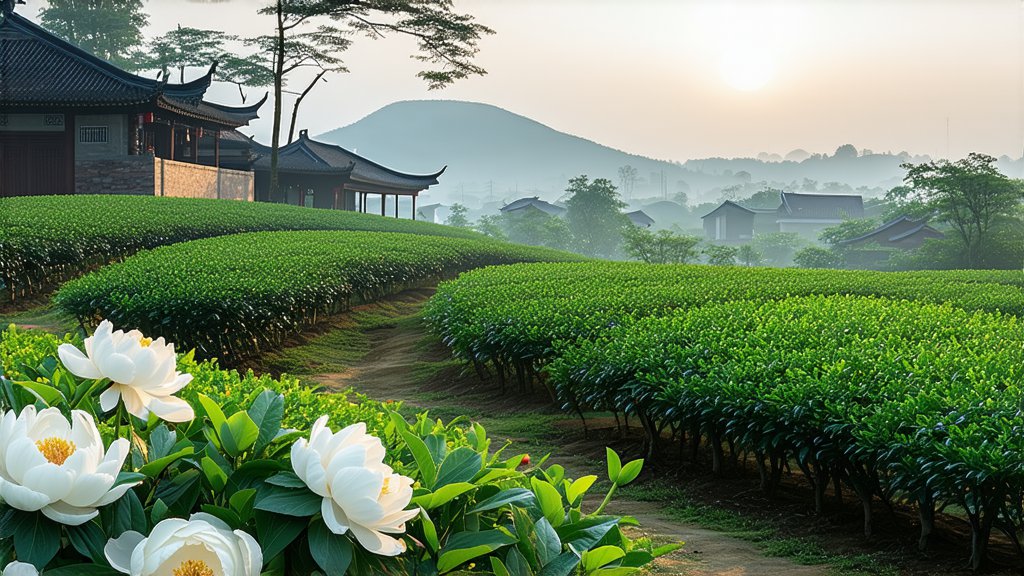
The Ethereal White Peony Tea: A Journey Through Chinese Tea Culture
In the vast and diverse landscape of Chinese tea culture, few varieties capture the essence of tranquility and elegance as profoundly as Bai Mu Dan, or White Peony tea. This exquisite tea, originating from the Fujian Province, is a testament to China's rich tea heritage and its enduring influence on global tea traditions. As a distinguished tea culture researcher and master tea artisan, I invite you to embark on a journey through the history, varieties, production process, and appreciation methods of this enchanting tea.
Historical Background
Bai Mu Dan tea traces its roots back to the Tang Dynasty (618-907 AD), a period marked by significant advancements in tea cultivation and consumption. It was during this era that tea became not just a beverage but a symbol of sophistication and social status. The name "White Peony" is derived from the resemblance of its downy buds and tender leaves to the delicate petals of a peony flower, symbolizing purity and grace.
Varieties of White Peony Tea
White Peony tea primarily comes from two main sub-varieties based on the region of cultivation within Fujian Province:
-
Fuding White Peony: Grown in Fuding County, these teas are known for their floral aroma and slightly sweet flavor profile. The terroir of Fuding contributes uniquely to the tea's character, influenced by the local climate and soil composition.
-
Zhenghe White Peony: Cultivated in Zhenghe County, these teas often exhibit a more robust flavor with hints of fruitiness and a lingering aftertaste. The distinct environmental factors of Zhenghe impart a different nuance to the tea.
The Art of Bai Mu Dan Production
The production of Bai Mu Dan tea is a meticulous process that involves several key steps:
-
Plucking: The finest Bai Mu Dan teas are made from the top two leaves and a bud, plucked with utmost care to preserve the integrity of the leaves. This typically occurs in early spring when the leaves are most tender and nutrient-rich.
-
Withering: After plucking, the leaves undergo a natural withering process, either under the sun or in a well-ventilated area. This step reduces moisture content and initiates enzymatic reactions that contribute to the tea's flavor and aroma.
-
Fixation: To halt oxidation, the withered leaves are briefly exposed to high heat, either through steaming or pan-frying. This step sets the foundation for the tea's final taste profile.
-
Shaking and Sorting: The leaves are gently shaken to separate the different grades of leaves and buds, ensuring uniformity in the final product. Higher-grade Bai Mu Dan consists predominantly of buds and downy leaves.
-
Drying: Finally, the tea is slowly dried to remove any remaining moisture, allowing it to be stored without deterioration. This careful drying process ensures the tea retains its delicate flavors and aromas.
Appreciating Bai Mu Dan Tea
To fully appreciate Bai Mu Dan tea, one must engage in a mindful tea ceremony that honors its subtleties. Here are some guidelines for an authentic tasting experience:
-
Preparation: Use water just below boiling point (around 80-85°C or 176-185°F) to avoid scalding the delicate leaves. A Gaiwan or Yixing teapot is recommended for brewing.
-
Infusion: Place approximately 5 grams of Bai Mu Dan tea per 150 ml of water. Steep for 1-2 minutes for the first infusion, gradually increasing steeping time for subsequent infusions. Bai Mu Dan can typically yield 5-7 infusions.
-
Observation: Admire the pale yellow liquor, which should appear clear and bright. The aroma should be floral with hints of honey and a subtle fruitiness.
-
Tasting: Sip slowly, allowing the tea to coat your palate. Notice the smooth texture and the interplay between sweetness and slight astringency. The finish should be clean and refreshing, leaving a lasting impression.
-
Reflection: Take a moment to reflect on the tea's characteristics and how they evolve with each infusion. Bai Mu Dan offers a journey for the senses, revealing new layers of flavor and aroma with every cup.
Conclusion
White Peony tea is more than just a beverage; it is a cultural artifact that encapsulates centuries of tradition, artistry, and reverence for nature. From its historical significance to its intricate production process and nuanced appreciation methods, Bai Mu Dan represents the pinnacle of Chinese tea craftsmanship. As you explore this ethereal tea, may you find not only enjoyment but also a deeper connection to the rich tapestry of Chinese tea culture.